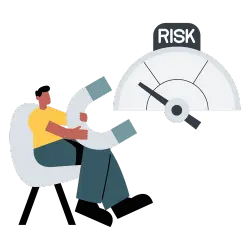TABLE OF CONTENTS
High-risk transactions include any credit card payment associated with an elevated possibility of financial loss. Because they come in many forms, it can be difficult to identify whether or not you accept high-risk transactions within your business operations. In fact, even low-risk businesses likely process riskier transactions within their operations. Wondering if your business accepts high-risk transactions? Find out below in our guide outlining which transactions are considered high risk, why they’re considered high risk, and how to stay protected with a high-risk merchant account while processing them.
What Does High-Risk Transaction Mean?
Technically speaking, all credit card transactions are risky, but some are riskier than others. High-risk transactions refer to credit card payments associated with significant risks of chargebacks, fraud, and other potential issues, like money laundering.
With evidence showing that 75% of eCommerce businesses saw an increase in fraud attempts in 2021, it’s more important than ever to understand high-risk transactions, as this is the first step in mitigating the risk of these transactions.[1]Chargebacks911. “Chargeback Stats. The Most Up-to-Date Dispute Data Points Available“. Accessed May 8, 2023.
High-Risk Transactions Examples
Card-not-present transactions
Card-not-present (CNP) transactions refer to payments in which the cardholder does not present a physical card at the time of payment. Payments accepted online, over the phone, and through email are all examples of card-not-present transactions. Because it’s easier for fraudsters to use stolen credit card numbers when they don’t have to show a physical card, this type of payment is considered a high-risk transaction.

First-time customers
First-time customers are typically at higher risk of committing fraud than repeat customers. With repeat customers, you have established relationships with them, so you can be more confident they’re using legitimate cards to make payments.
International transactions
International transactions pose a risk to businesses because security measures, banking regulations, and fraud prevention vary heavily in other countries—making it easier for malicious actors to execute various types of fraud. Likewise, fighting disputes or seeking damages may be more challenging if the payment originated overseas.

High-ticket purchases
Regardless of your business’s industry, high-ticket purchases can result in significant losses for merchants and payment processors. If you sell products or services with an expensive price tag, reducing your chances of receiving fraudulent charges is of the utmost importance. Otherwise, a single transaction could end up costing you a lot. Likewise, most high-volume businesses are considered high-risk.
Transactions in high-risk industries
Lastly, some industries are more prone to chargebacks, fraud, and regulatory issues than others because of the products or services they sell. This can sometimes be confusing to merchants, so let’s explore the some of the most common high-risk industries below:
- Adult
- CBD
- Bail bonds
- Firearms
- Drop shipping
- MLM
- Nutraceuticals
- Tech support
- Tobacco
- Travel
Low-Risk Transactions Examples

In-person transactions
While in-person transactions are not immune to financial risk, they pose a reduced likelihood of financial loss than card-not-present transactions. The reason for this is that stealing credit card numbers is easier than stealing physical credit cards.
Chip-related transactions
Many payment processors insist their merchants use EMV payment solutions, as it reduces the risk for all parties involved in a transaction. Accepting card payments via EMV chip makes these payments significantly more secure, adding protection to business owners across the globe. While chipless cards still exist, more than 90% of credit card payments are now made with EMV chip cards.[2]NFCW. “More than 90% of card-present payments worldwide were made using EMV chip cards in 2021“. Accessed January 9, 2023.

Transactions with digital authentication
Card networks and other parties involved in payment processing now offer authentication tools to reduce the risk level associated with payments. Their programs, such as Verified by Visa, make it more challenging for scammers to use stolen credit card numbers online.
Low-risk products
Just like there are high-risk products, there are also low-risk products. If you sell goods or services considered “safe,” your chances of fraud can be greatly reduced. Typically, goods and services that don’t have to comply with too much regulation are considered low-risk products.
How to Protect Your Business from High-Risk Transaction Fraud

Protecting your business from high-risk transaction fraud is a critical part of owning a business. However, the most effective strategy for reducing exposure to fraud varies depending on the type of payment. Below explores how to protect your business, depending on the type of transaction.
Card-not-present transactions
With card-not-present transactions, further security measures are necessary to combat fraud. Let’s explore some common tools to mitigate high-risk transaction fraud when you don’t have physical possession of your customer’s card:
- CVV Verification: Credit cards usually have a card verification value (CVV) printed on the back of the physical card. Utilizing a payment system that requires this number, in addition to the standard credit card number, can help you avoid high-risk transaction fraud.
- Address Verification: Merchants also use address verification to require a credit card holder to input the correct zip code and address details. This form of verification ensures only individuals with the correct address can successfully use the credit card, making it more challenging for scammers to use card numbers from data leaks.
- Two-Factor Authentication: Two-factor authentication is a method that requires cardholders to confirm they’ve received a code via SMS or email. With this security measure, a customer may receive a code to their registered phone number. This code must be entered correctly into the payment gateway before the payment is finalized.
- Card Association Tools: Card networks—such as Visa, Mastercard, Discover, and American Express—offer a range of tools to help combat the fraudulent use of credit cards. By implementing these tools, you’ll ensure your business stays up-to-date with the latest technologies for mitigating the risk associated with accepting card-not-present transactions.

Card-present transactions
For transactions involving present credit or debit cards, there are different methods of protecting your business from fraudulent payments. Let’s explore some security options below:
- EMV Payments: EMV chips provide additional security for merchants and cardholders. Accepting chip payments instead of magstripe payments helps to combat card-present fraud.
- Fight Chargebacks: If you don’t fight fraudulent chargebacks, your business may become a target for fraudsters. Recording transaction data—including payment details and shipping confirmation—will help you win chargeback disputes and deter future scammers.
- Follow Compliance: Following PCI compliance guidelines and utilizing data encryption software will help reduce your exposure to all forms of credit card deception, including card-present fraud.
High-Risk Transactions and Authentication

Using forms of authentication—including the aforementioned CVV code, address, and two-factor authentication—can mitigate risks associated with credit card payments. However, consumers tend to prefer quick, seamless transactions without the need for passwords, SMS codes, security questions, and other forms of authentication. As a merchant, balancing the need for credit card authentication while providing convenience to your customers can be challenging.
While customers may find authentication annoying, the modern payment landscape requires businesses to utilize ample security measures. Even though authentication is not a legal requirement, forgoing it can expose your business to increased chargebacks and fraud. Once your chargeback ratio exceeds acceptable levels, your business may face increased chargeback fees, increased high-risk processing fees, and the loss of your business’s merchant account altogether. Additionally, card associations may pursue legal action if your business is negligent in allowing the occurrence of chargebacks and fraud.
Fortunately, there are security tools with which authentication does not have a reduced impact on payment speed. For example, some payment gateways allow customers to save payment details to an account, bypassing the need for inputting payment information every time they purchase a product or service online.
Lastly, authentication is not foolproof. Scammers are increasingly capable of hacking email accounts, bypassing security measures, and using various strategies to avoid detection from authentication tools. While authentication is necessary for businesses accepting online payments, fraud may still occur.
Final Thoughts on High-Risk Transactions
Accepting high-risk transactions within your operations doesn’t need to be risky—that is, if you have the right systems in place. Significant risks can be mitigated with chargeback prevention tools, fraud reduction strategies, and other such mechanisms offered by merchant service providers. If you’d like to reduce financial losses from credit card payments, consider choosing a high-risk merchant services provider. At PaymentCloud, we offer advanced security services to protect both low- and high-risk businesses from the financial risks associated with high-risk transactions.
All Businesses Deserve a Chance
We can approve almost any business type!
Approval
Rating






